Are you tired of seeing smudges and streaks on your beautiful black granite countertops? Are you unsure of how to properly clean and maintain them? Look no further, as we provide you with a step-by-step guide on how to clean black granite countertops.
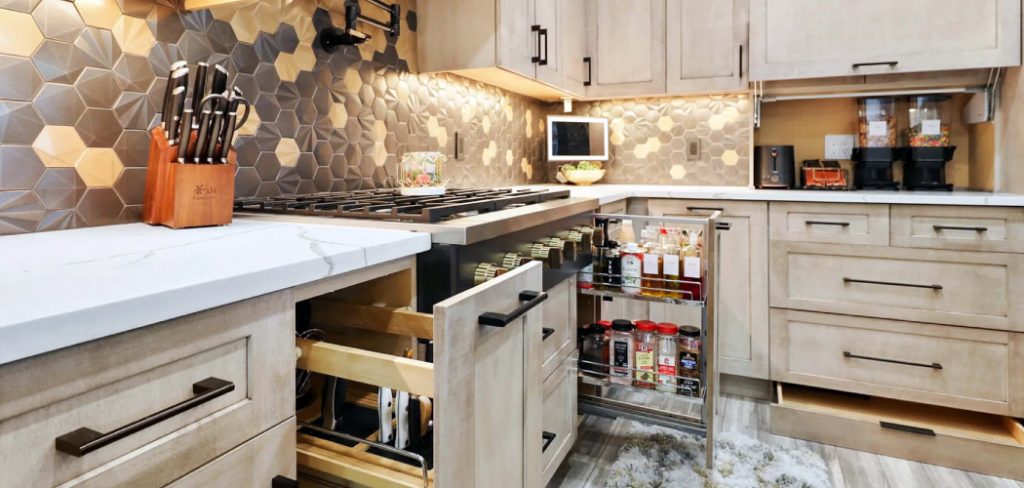
Black granite countertops are a stunning and durable addition to any kitchen or bathroom, offering a sleek, sophisticated look that enhances any space. However, maintaining their glossy finish and pristine appearance requires proper care and cleaning. Black granite is a natural stone, and while it is highly resistant to scratches and heat, it is still susceptible to stains, dullness, and damage if cleaned incorrectly. By following the proper cleaning techniques and using appropriate products, you can preserve the beauty and longevity of your black granite surfaces for years to come.
This guide will walk you through the best practices for cleaning and caring for your countertops.
What Are the Causes of Stains on Black Granite Countertops?
Before we dive into the cleaning process, it’s essential to understand what causes stains on your black granite countertops. While this stone is known for its durability and resistance to staining, it is still porous and can absorb liquids if not sealed properly. Some common culprits that can leave stains include:
- Oil-based substances like cooking oils, greasy food, and makeup products
- Acidic substances like vinegar, citrus fruits, and tomato juice
- Colored liquids such as wine, coffee, and tea
To prevent these substances from causing permanent stains on your black granite countertops, it’s crucial to clean up spills immediately and avoid leaving them sitting for an extended period.
What Will You Need?
Before you start cleaning, gather the necessary supplies. Here’s what you’ll need:
- Warm water
- Mild dish soap or granite cleaner
- Soft microfiber cloths or non-abrasive sponges
- A spray bottle
- Neutral pH cleaner (optional)
- Stone sealer (if required)
Once you have all the materials, you can begin the cleaning process.
9 Easy Steps on How to Clean Black Granite Countertops
Step 1: Prepare the Surface
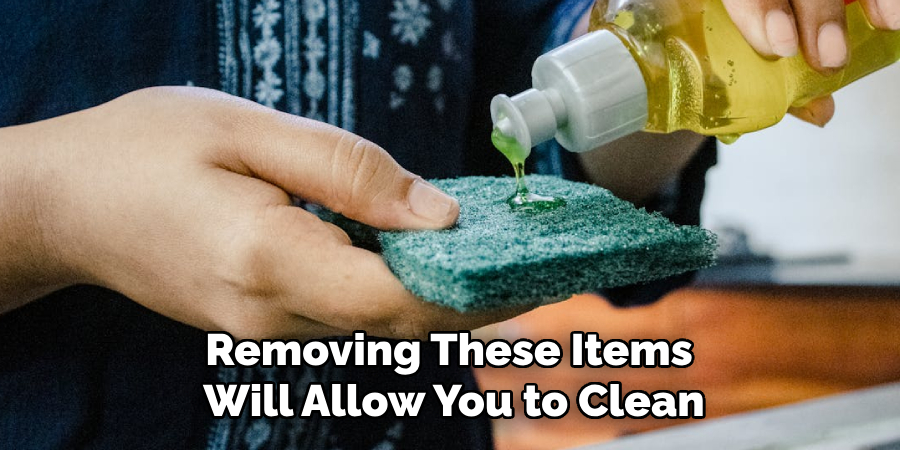
Before you begin cleaning, clear the countertop of any items like dishes, appliances, or decorations to ensure you have a clean and unobstructed surface to work on. Removing these items will allow you to clean every part of the granite effectively. Once cleared, gently wipe off loose debris such as crumbs or dust with a dry microfiber cloth to prevent scratching the surface during the cleaning process. This initial step sets the stage for a thorough and effective cleaning session while protecting the integrity of your black granite countertop.
Step 2: Create a Cleaning Solution
To create an effective cleaning solution, fill a spray bottle with warm water. Add a few drops of mild dish soap or a granite-safe cleaner to the water, ensuring it is gentle and free of harsh chemicals like ammonia or bleach, as these can damage the surface of the granite over time. Shake the bottle gently to mix the solution, but avoid creating too many suds. If you prefer, you can also opt for a neutral pH cleaner specifically designed for stone surfaces, as this will provide optimal cleaning without harming the natural characteristics of the granite. Keep your cleaning solution nearby as you proceed to clean the countertop.
Step 3: Apply the Cleaning Solution
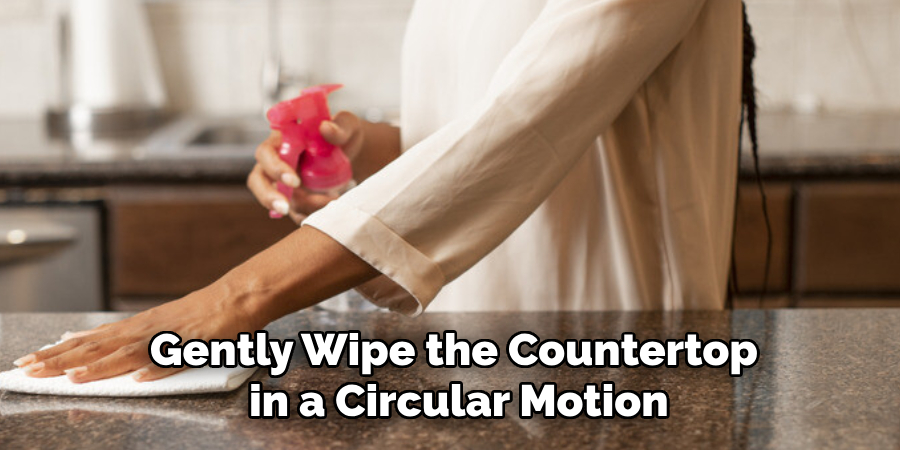
Spray the cleaning solution evenly across the surface of the black granite countertop. Focus on areas with visible smudges, fingerprints, or minor stains, but be careful not to oversaturate the surface. Using a soft, non-abrasive cloth or sponge, gently wipe the countertop in a circular motion. This technique helps lift dirt and grime without causing streaks or scratches. For stubborn spots, allow the solution to sit for a minute before wiping to loosen the residue. Once the surface is clean, proceed to the next step to ensure a flawless finish.
Step 4: Rinse and Dry the Surface
After cleaning the countertop, use a clean, damp cloth to wipe away any remaining cleaning solution. It’s essential to thoroughly rinse the surface to prevent residue buildup, which can dull the shine of the granite over time. Once rinsed, dry the countertop immediately using a soft, lint-free towel or microfiber cloth. Drying ensures no water spots form and helps maintain the sleek, polished look of the black granite.
Step 5: Apply a Granite Sealer
To protect your black granite countertop and preserve its polished appearance, it’s essential to apply a granite sealer periodically. Begin by ensuring the surface is completely dry from the previous step. Apply the sealer in a thin, even layer across the countertop using a soft cloth, following the product instructions carefully. Allow the sealer to sit for the recommended time, typically 15-20 minutes, to soak into the stone. Once the time has elapsed, use a clean, dry cloth to buff the surface until it shines. Proper sealing helps prevent stains, water damage, and dullness, ensuring your black granite remains stunning for years.
Step 6: Perform Regular Maintenance
Regular maintenance is key to keeping your black granite countertop looking its best. Clean up spills immediately to prevent staining, especially from liquids like wine, coffee, or citrus juice that can damage the stone’s finish. Use a pH-balanced cleaner designed for granite to wipe down the surface daily, ensuring it stays free of grime and residue. Avoid harsh chemicals or abrasive scrubbers, as they can harm the granite’s seal and finish. By incorporating these simple practices into your routine, you’ll maintain the elegance and durability of your black granite countertop.
Step 7: Address Repairs Promptly
If your black granite countertop develops chips, scratches, or cracks, it’s essential to address them promptly to prevent further damage. Minor chips or scratches can often be repaired using a granite repair kit, which typically includes epoxy resin and color-matching materials. For larger cracks or significant damage, seek the expertise of a professional stone specialist to ensure proper restoration. Regularly inspecting your countertop for signs of wear and addressing issues quickly will help preserve its natural beauty and extend its lifespan.
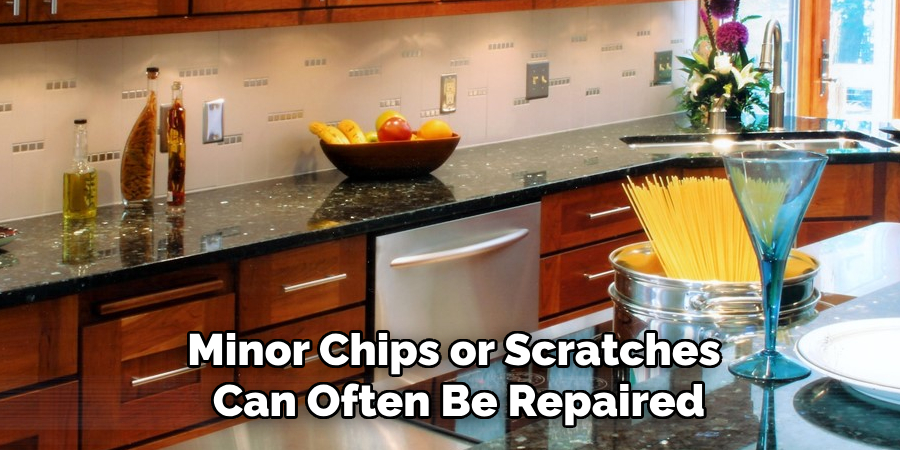
Step 8: Utilize Adequate Support for Heavy Items
To protect your black granite countertop from unnecessary stress or damage, ensure adequate support for heavy items placed on its surface. Avoid placing hefty appliances or objects near edges or corners, as this can increase the risk of cracks or fractures. If heavy items must be placed on the countertop, distribute the weight evenly or use protective padding to minimize pressure. Taking these precautions will help maintain the structural integrity of your granite countertop for years.
Step 9: Protect Against Heat Damage
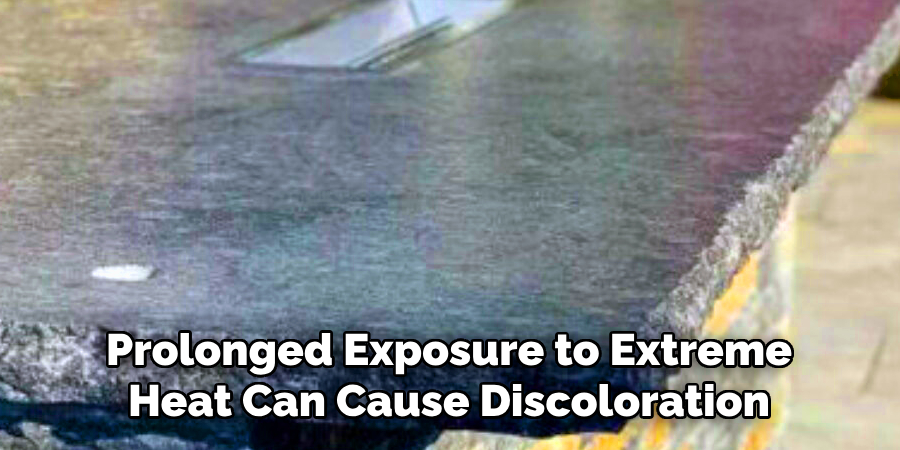
While black granite countertops are heat resistant, taking precautions to prevent potential damage from high temperatures is still important. Always use trivets, heat-resistant mats, or hot pads when placing hot pots, pans, or baking dishes on the countertop. Prolonged exposure to extreme heat can cause discoloration or weaken the sealant, reducing the granite’s durability. By implementing these protective measures, you can maintain the countertop’s pristine appearance and functionality over time.
By following these nine simple steps, you can ensure your black granite countertop remains a stunning centerpiece in your home for years.
5 Things You Should Avoid
- Using Harsh Chemicals or Cleaners: Avoid using cleaners that contain acidic ingredients, such as vinegar, lemon juice, or ammonia. These substances can etch the surface of the granite and damage the sealant, leading to dullness and potential staining over time. Stick to pH-neutral, granite-safe cleaners for optimal care.
- Scrubbing with Abrasive Pads: Never use steel wool, scouring pads, or other abrasive tools to clean your black granite countertop. These materials can cause scratches that are not only unsightly but can also trap dirt and bacteria. Use a soft microfiber cloth or non-abrasive sponge instead.
- Allowing Liquids to Sit for Long Periods: Spills should be permanently wiped up promptly to prevent staining. Prolonged exposure to liquids, especially those containing oils or dyes, can penetrate the granite’s surface and leave permanent marks, even if the countertop is sealed.
- Skipping Regular Sealing: Failing to reseal your black granite countertop as needed can lead to losing its protective barrier. The porous stone is vulnerable to stains, moisture damage, and dullness without proper sealing. Regularly check and maintain the sealant to preserve its beauty and durability.
- Placing Extremely Heavy Items: Although granite is durable, placing excessive weight on the countertop edges or overhangs can cause cracking or structural damage. Avoid standing, sitting, or placing overly heavy items on the countertop to maintain its integrity.
By steering clear of these common mistakes, you can extend the longevity of your black granite countertops while keeping them looking polished and elegant.
Conclusion
Cleaning black granite countertops properly is essential to maintain their sleek appearance and long-lasting durability.
Always use a pH-balanced cleaner or a mixture of mild dish soap and warm water to avoid damaging the surface. Gently wipe the countertop with a soft cloth or sponge, and dry it thoroughly to prevent water spots. Avoid abrasive tools or harsh chemicals, which can scratch or dull the stone’s finish. Your black granite countertops will retain their luster and elegance with consistent care and a proper cleaning routine.
Hopefully, the article on how to clean black granite countertops has been informative and helpful. Happy cleaning!
Professional Focus
Angela Ervin, a former interior designer turned blogger, specializes in kitchen design and renovations. Through her website, she blends her passion for cooking with design expertise, sharing practical and creative ideas. Known for balancing functionality and beauty, Angela’s insightful content has made her a trusted voice in home design and lifestyle.
About the Author
Angela Ervin, an experienced interior designer and blogger, combines her passion for kitchen renovations with storytelling. Living in Petersburg with her family, she enjoys cooking and testing her projects firsthand. Known for her humor and relatable style, Angela shares creative, functional design insights through her content, making her a trusted voice in home design.
Education History
University: Virginia Commonwealth University
Degree: Bachelor of Fine Arts (BFA) in Interior Design
- Angela’s education at VCU focused on mastering core interior design principles, including spatial planning, color theory, materials selection, and sustainable design practices.
- She gained hands-on experience through studio projects and collaborative design exercises, which honed her ability to create functional and aesthetically pleasing environments.
- Her coursework also emphasized problem-solving and practical applications of design, preparing her for real-world projects like her self-directed kitchen renovations.
- The program’s strong foundation in both technical skills and creative expression shaped Angela’s ability to seamlessly integrate form and function in her work.
